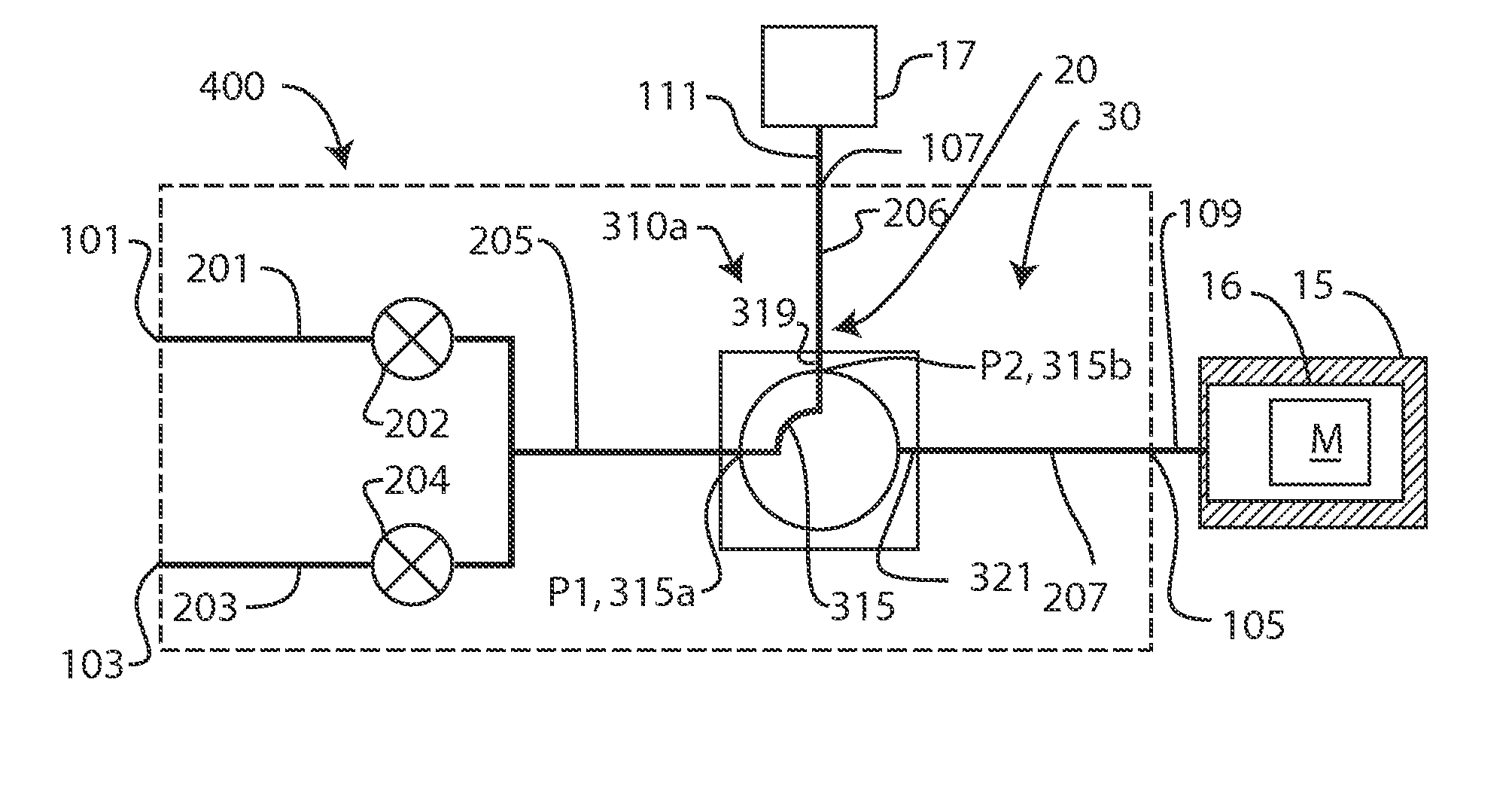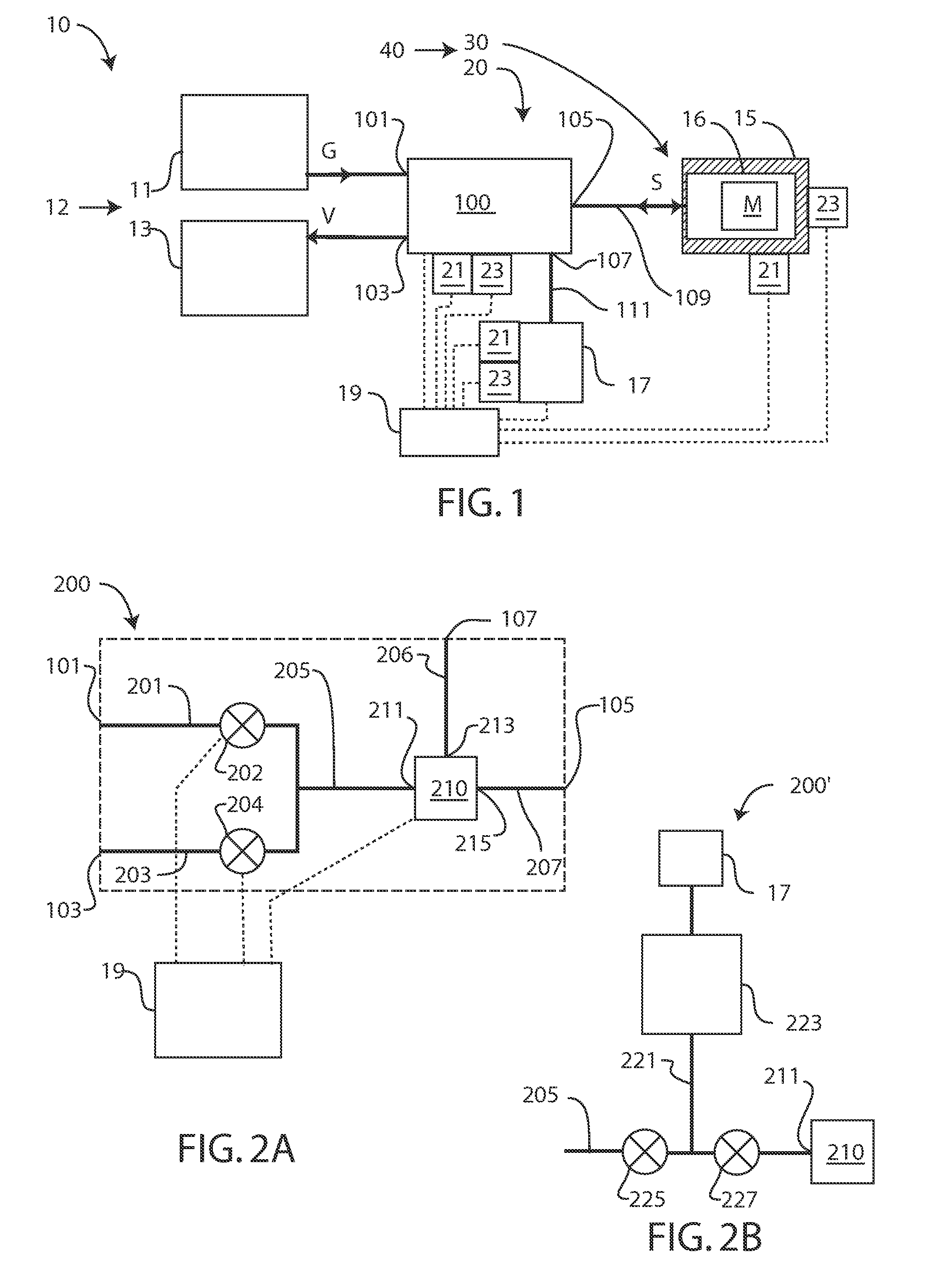Method and apparatus for handling small quantities of fluids
a technology for handling fluids and small quantities, applied in the direction of measuring devices, sampling, instruments, etc., can solve the problems of significant measurement errors, unresolved pct curves, and internal volume change in the system as a whol
- Summary
- Abstract
- Description
- Claims
- Application Information
AI Technical Summary
Benefits of technology
Problems solved by technology
Method used
Image
Examples
first embodiment
[0077]FIG. 2A is a schematic diagram of a first embodiment valve system 200 of the present invention which may be generally similar to valve system 100, except as further detailed below. Where possible, similar elements are identified with identical reference numerals.
[0078]Valve system 200 includes a first valve 202, a second valve 204, a third valve 210, having a first port 211, a second port 213, and a third port 215, each under the control of computer system 19, and passageways 201, 203, 205, 206, and 207. Passageway 201 connects port 101 and first valve 202, passageway 203 connects port 103 and second valve 202, passageway 205 connects the first and second valves to first port 211, passageway 206 connects second port 213 to port 107, and passageway 207 connects third port 215 to port 105.
[0079]First valve 202 and second valve 204 are on / off valves that are electrically controlled by computer system 19 to control fluid communication between ports 101 and 103, respectively, and t...
second embodiment
[0095]In one embodiment, valve 510 is a rotary valve. FIGS. 6A and 6B are schematic diagrams of a rotary valve 610 suitable for use as valve 510, where FIG. 6A shows rotary valve 610 in a first position 610a, and FIG. 6B shows rotary valve 610 in a second position 610b. Rotary valve 610 may be generally similar to valves 210, 310, or 510, except as further detailed below. Where possible, similar elements are identified with identical reference numerals.
[0096]Rotary valve 610 has a housing 611, which is generally similar to housing 311, except that it does not have a passageway 319. Rotary valve 610 is a two-port, two-position valve, where FIG. 6A shows the rotary valve in a first position 610a and FIG. 6B shows the rotary valve in a second position 610b. The use of rotary valve 610 for valve 510 can result in a lower dosing volume, since the port for measuring pressure (such as port 213 of FIG. 2) is eliminated, further reducing the volume of dosing reservoir 20 to the volume of pas...
third embodiment
[0101]FIG. 9 is a schematic diagram of a dosing / bypass valve system 900 of the present invention which may be generally similar to valve systems 100, 200, 400, 500, 700, or 800 except as further detailed. Where possible, similar elements are identified with identical reference numerals.
[0102]Dosing / bypass valve system 900 includes a valve 910 having at least four ports and three positions. More specifically, valve 910 has first, second, and third ports 211, 213, and 215, respectively, and a fourth port 903, and a passageway 901 that connects passageway 207 to port 903. Valve 910, which may be generally similar to valve 210, 510, or 810 except as noted subsequently, includes a third position that connects ports 903 and 211. As with valve 210, and 810, valve 910 has a first position that connects that connects ports 211 and 213, a second position that connects ports 213 and 215. The third position that connects ports 903 and 211 and which is useful, in measurement apparatus 10, in pro...
PUM
| Property | Measurement | Unit |
|---|---|---|
| volume | aaaaa | aaaaa |
| volume | aaaaa | aaaaa |
| volumes | aaaaa | aaaaa |
Abstract
Description
Claims
Application Information
 Login to View More
Login to View More - R&D
- Intellectual Property
- Life Sciences
- Materials
- Tech Scout
- Unparalleled Data Quality
- Higher Quality Content
- 60% Fewer Hallucinations
Browse by: Latest US Patents, China's latest patents, Technical Efficacy Thesaurus, Application Domain, Technology Topic, Popular Technical Reports.
© 2025 PatSnap. All rights reserved.Legal|Privacy policy|Modern Slavery Act Transparency Statement|Sitemap|About US| Contact US: help@patsnap.com



